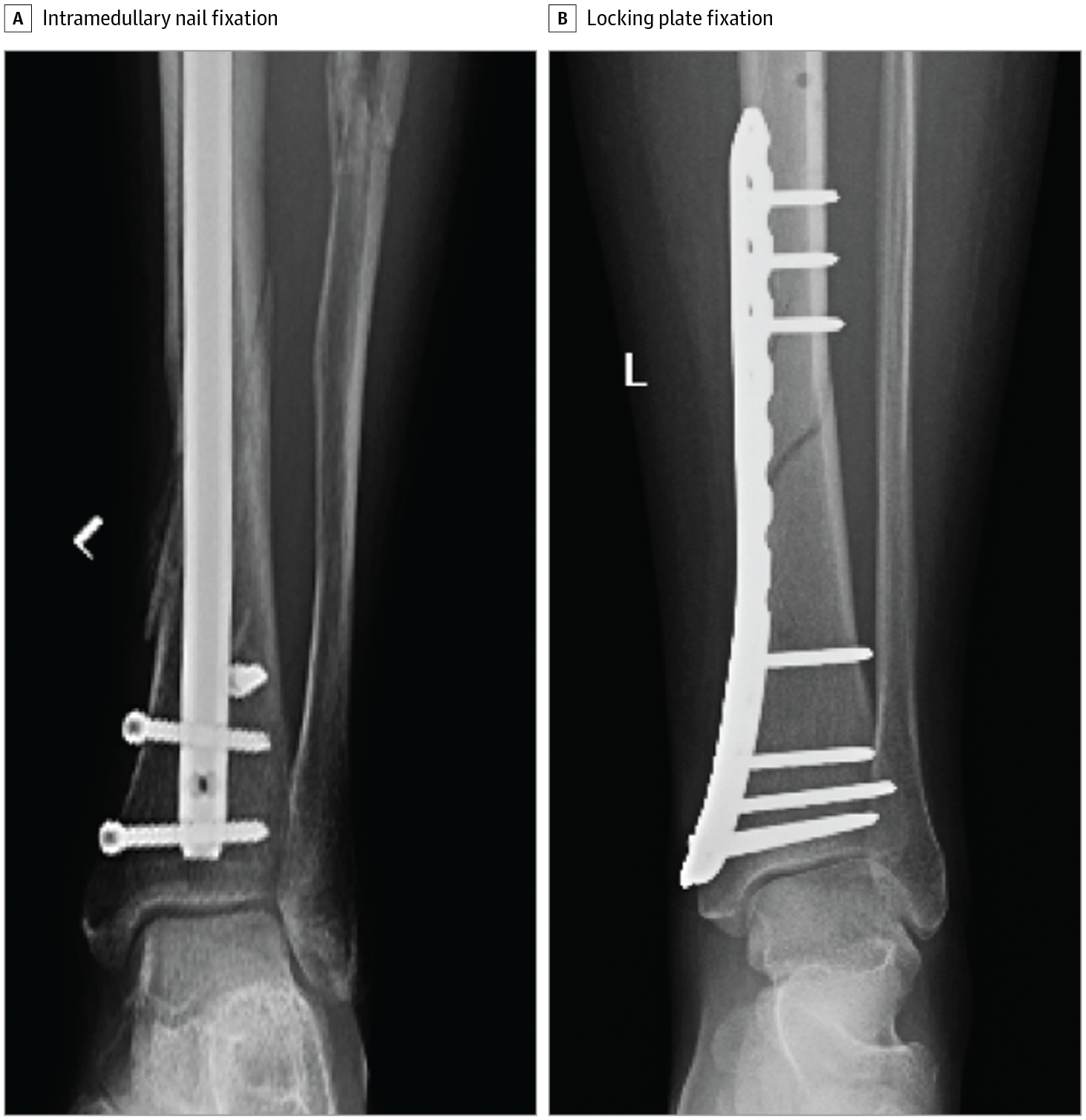Our official English website, www.x-mol.net, welcomes your
feedback! (Note: you will need to create a separate account there.)
Effect of Locking Plate Fixation vs Intramedullary Nail Fixation on 6-Month Disability Among Adults With Displaced Fracture of the Distal Tibia
JAMA ( IF 63.1 ) Pub Date : 2017-11-14 , DOI: 10.1001/jama.2017.16429 Matthew L. Costa 1 , Juul Achten 2 , James Griffin 3 , Stavros Petrou 3 , Ian Pallister 4 , Sarah E. Lamb 2 , Nick R. Parsons 5 ,
JAMA ( IF 63.1 ) Pub Date : 2017-11-14 , DOI: 10.1001/jama.2017.16429 Matthew L. Costa 1 , Juul Achten 2 , James Griffin 3 , Stavros Petrou 3 , Ian Pallister 4 , Sarah E. Lamb 2 , Nick R. Parsons 5 ,
Affiliation

|
Importance The best treatment for fractures of the distal tibia remains controversial. Most such fractures require surgical fixation but outcomes are unpredictable and complications are common. Objective To assess disability, quality of life, and complications in patients with displaced tibial fracture treated with intramedullary nail fixation vs locking plate fixation. Design, Setting, and Participants A multicenter randomized trial recruiting 321 patients 16 years or older with an acute, displaced, extra-articular fracture of the distal tibia from April 2013 through April 2016 with final follow-up in February 2017. Exclusion criteria included open fractures, fractures involving the ankle joint, contraindication to nailing, or inability to complete questionnaires. Interventions Intramedullary nail fixation (nail group; n = 161), a metal rod inserted into the hollow center of the tibia, vs locking plate fixation (plate group; n = 160), a plate attached to the surface of the tibia with fixed-angle screws. Main Outcomes and Measures Disability Rating Index (DRI; score range, 0 [no disability] to 100 [complete disability]) at 6 months was the primary outcome measure, with a minimal clinically important difference of 8 points. DRI measurement was also collected at 3 and 12 months. Secondary outcomes were the Olerud-Molander Ankle Score (OMAS), quality of life, and complications (such as infection and further surgery). Results Among 321 randomized patients (mean age, 45 years [SD, 16.2]; men, 197 [61%]; had experienced traumatic injury after a fall, 223 [69%]), 258 completed the study. There was no statistically significant difference in the DRI score at 6 months between groups (mean score, 29.8 in the nail group vs 33.8 in the plate group; adjusted difference, 4.0 [95% CI, −1.0 to 9.0], P = .11). There was a statistically significant difference in the DRI score at 3 months in favor of nail fixation (mean score, 44.2 in the nail group and 52.6 in the plate group; adjusted difference, 8.8 [95% CI, 4.3 to 13.2], P < .001), but not at 12 months (mean score, 23.1 in the nail group and 24.0 in the plate group; adjusted difference, 1.9 [95% CI, −3.2 to 6.9], P = .47). Secondary outcomes showed the same pattern, including a statistically significant difference in mean OMAS at 3 and 6 months in favor of nail fixation. There were no statistically significant differences in complications, including the number of postoperative infections (9% in the nail group vs 13% in the plate group). Further surgery was more common in the plate group at 12 months (8% in nail group vs 12% in plate group). Conclusions and Relevance Among patients 16 years or older with an acute, displaced, extra-articular fracture of the distal tibia, neither nail fixation nor locking plate fixation resulted in superior disability status at 6 months. Other factors may need to be considered in deciding the optimal approach. Trial Registration clinicaltrials.gov Identifier: ISRCTN99771224
中文翻译:

锁定钢板固定与髓内钉固定对胫骨远端移位性骨折成人 6 个月残疾的影响
重要性 胫骨远端骨折的最佳治疗方法仍有争议。大多数此类骨折需要手术固定,但结果不可预测且并发症很常见。目的 评估髓内钉固定与锁定钢板固定治疗移位性胫骨骨折患者的残疾、生活质量和并发症。设计、设置和参与者 一项多中心随机试验,招募了 321 名 16 岁或以上的 2013 年 4 月至 2016 年 4 月的胫骨远端急性移位关节外骨折患者,最终随访时间为 2017 年 2 月。排除标准包括开放性骨折、踝关节骨折、钉钉禁忌症或无法完成问卷调查。干预髓内钉固定(钉组;n = 161),插入胫骨中空中心的金属棒,vs 锁定板固定(板组;n = 160),用固定角度螺钉连接到胫骨表面的板。主要结果和衡量指标 6 个月时的残疾评定指数(DRI;评分范围,0 [无残疾] 至 100 [完全残疾])是主要结果衡量指标,最小临床重要差异为 8 分。还在 3 个月和 12 个月时收集了 DRI 测量值。次要结果是 Olerud-Molander 踝关节评分 (OMAS)、生活质量和并发症(如感染和进一步手术)。结果 在 321 名随机患者(平均年龄,45 岁 [SD,16.2];男性,197 [61%];跌倒后经历过外伤,223 [69%])中,258 名完成了研究。组间 6 个月时的 DRI 评分无统计学显着差异(指甲组平均评分为 29.8,钢板组为 33.8;调整后差异为 4.0 [95% CI,-1.0 至 9.0],P = .11 )。有利于钉固定的 3 个月 DRI 评分存在统计学显着差异(平均评分,钉组为 44.2,钢板组为 52.6;调整后差异为 8.8 [95% CI,4.3 至 13.2],P < .001),但不是在 12 个月时(平均评分,钉组为 23.1,钢板组为 24.0;调整后的差异为 1.9 [95% CI,-3.2 至 6.9],P = .47)。次要结果显示出相同的模式,包括在 3 个月和 6 个月时平均 OMAS 有统计学显着差异,有利于钉固定。并发症无统计学差异,包括术后感染的数量(钉组为 9%,钢板组为 13%)。12 个月时,钢板组进一步手术更为常见(指甲组为 8%,钢板组为 12%)。结论和相关性 在 16 岁或以上的胫骨远端急性移位关节外骨折患者中,钉固定和锁定钢板固定在 6 个月时均未导致更好的残疾状态。在决定最佳方法时可能需要考虑其他因素。试验注册clinicaltrials.gov 标识符:ISRCTN99771224 胫骨远端关节外骨折,钉固定和锁定钢板固定均未在 6 个月时导致优异的残疾状态。在决定最佳方法时可能需要考虑其他因素。试验注册clinicaltrials.gov 标识符:ISRCTN99771224 胫骨远端关节外骨折,钉固定和锁定钢板固定均未在 6 个月时导致优异的残疾状态。在决定最佳方法时可能需要考虑其他因素。试验注册clinicaltrials.gov 标识符:ISRCTN99771224
更新日期:2017-11-14
中文翻译:

锁定钢板固定与髓内钉固定对胫骨远端移位性骨折成人 6 个月残疾的影响
重要性 胫骨远端骨折的最佳治疗方法仍有争议。大多数此类骨折需要手术固定,但结果不可预测且并发症很常见。目的 评估髓内钉固定与锁定钢板固定治疗移位性胫骨骨折患者的残疾、生活质量和并发症。设计、设置和参与者 一项多中心随机试验,招募了 321 名 16 岁或以上的 2013 年 4 月至 2016 年 4 月的胫骨远端急性移位关节外骨折患者,最终随访时间为 2017 年 2 月。排除标准包括开放性骨折、踝关节骨折、钉钉禁忌症或无法完成问卷调查。干预髓内钉固定(钉组;n = 161),插入胫骨中空中心的金属棒,vs 锁定板固定(板组;n = 160),用固定角度螺钉连接到胫骨表面的板。主要结果和衡量指标 6 个月时的残疾评定指数(DRI;评分范围,0 [无残疾] 至 100 [完全残疾])是主要结果衡量指标,最小临床重要差异为 8 分。还在 3 个月和 12 个月时收集了 DRI 测量值。次要结果是 Olerud-Molander 踝关节评分 (OMAS)、生活质量和并发症(如感染和进一步手术)。结果 在 321 名随机患者(平均年龄,45 岁 [SD,16.2];男性,197 [61%];跌倒后经历过外伤,223 [69%])中,258 名完成了研究。组间 6 个月时的 DRI 评分无统计学显着差异(指甲组平均评分为 29.8,钢板组为 33.8;调整后差异为 4.0 [95% CI,-1.0 至 9.0],P = .11 )。有利于钉固定的 3 个月 DRI 评分存在统计学显着差异(平均评分,钉组为 44.2,钢板组为 52.6;调整后差异为 8.8 [95% CI,4.3 至 13.2],P < .001),但不是在 12 个月时(平均评分,钉组为 23.1,钢板组为 24.0;调整后的差异为 1.9 [95% CI,-3.2 至 6.9],P = .47)。次要结果显示出相同的模式,包括在 3 个月和 6 个月时平均 OMAS 有统计学显着差异,有利于钉固定。并发症无统计学差异,包括术后感染的数量(钉组为 9%,钢板组为 13%)。12 个月时,钢板组进一步手术更为常见(指甲组为 8%,钢板组为 12%)。结论和相关性 在 16 岁或以上的胫骨远端急性移位关节外骨折患者中,钉固定和锁定钢板固定在 6 个月时均未导致更好的残疾状态。在决定最佳方法时可能需要考虑其他因素。试验注册clinicaltrials.gov 标识符:ISRCTN99771224 胫骨远端关节外骨折,钉固定和锁定钢板固定均未在 6 个月时导致优异的残疾状态。在决定最佳方法时可能需要考虑其他因素。试验注册clinicaltrials.gov 标识符:ISRCTN99771224 胫骨远端关节外骨折,钉固定和锁定钢板固定均未在 6 个月时导致优异的残疾状态。在决定最佳方法时可能需要考虑其他因素。试验注册clinicaltrials.gov 标识符:ISRCTN99771224











































 京公网安备 11010802027423号
京公网安备 11010802027423号